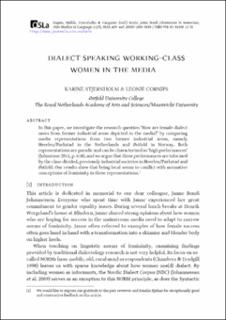| dc.contributor.author | Stjernholm, Karine | |
| dc.contributor.author | Cornips, Leonie | |
| dc.date.accessioned | 2021-02-15T22:16:48Z | |
| dc.date.available | 2021-02-15T22:16:48Z | |
| dc.date.created | 2021-01-26T10:36:52Z | |
| dc.date.issued | 2020 | |
| dc.identifier.citation | Oslo Studies in Language (OSLa). 2020, 11 (2), 429-447. | en_US |
| dc.identifier.issn | 1890-9639 | |
| dc.identifier.uri | https://hdl.handle.net/11250/2728213 | |
| dc.description.abstract | In this paper, we investigate the research question ‘How are female dialect users from former industrial areas depicted in the media?’ by comparing media representations from two former industrial areas, namely Heerlen/Parkstad in the Netherlands and Østfold in Norway. Both representations are parodic and can be characterised as ‘high performances’ (Johnstone 2011, p. 658), and we argue that these performances are informed by the class-divided, previously industrial societies in Heerlen/Parkstad and Østfold. Our results show that being local seems to conflict with normative conceptions of femininity in these representations. | en_US |
| dc.language.iso | eng | en_US |
| dc.publisher | Universitetet i Oslo | en_US |
| dc.rights | Navngivelse 4.0 Internasjonal | * |
| dc.rights.uri | http://creativecommons.org/licenses/by/4.0/deed.no | * |
| dc.title | Dialect speaking working-class women in the media | en_US |
| dc.type | Peer reviewed | en_US |
| dc.type | Journal article | en_US |
| dc.description.version | publishedVersion | en_US |
| dc.subject.nsi | VDP::Humaniora: 000::Språkvitenskapelige fag: 010 | en_US |
| dc.source.pagenumber | 429-447 | en_US |
| dc.source.volume | 11 | en_US |
| dc.source.journal | Oslo Studies in Language (OSLa) | en_US |
| dc.source.issue | 2 | en_US |
| dc.identifier.doi | 10.5617/osla.8511 | |
| dc.identifier.cristin | 1879367 | |
| cristin.ispublished | true | |
| cristin.fulltext | original | |
| cristin.qualitycode | 1 | |

